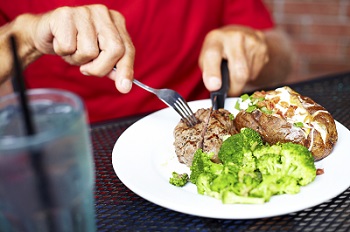Thousands of People Die From Choking Every Year
 According to Injury Facts, choking is the fourth leading cause of unintentional injury death. Of the 3,000 people who died from choking in 2020, 1,430 were older than 74. Food is often responsible for choking incidents in the elderly. Living alone, and having dentures or difficulty swallowing can increase risk. If you see someone clutching their throat, coughing, gagging, wheezing or passed out, would you know what to do?
According to Injury Facts, choking is the fourth leading cause of unintentional injury death. Of the 3,000 people who died from choking in 2020, 1,430 were older than 74. Food is often responsible for choking incidents in the elderly. Living alone, and having dentures or difficulty swallowing can increase risk. If you see someone clutching their throat, coughing, gagging, wheezing or passed out, would you know what to do?
The Heimlich Maneuver
If a person is coughing forcefully, encourage continued coughing to clear the object. A person who can't cough, speak or breathe, however, needs immediate help. Ask if they are choking and let them know you will use abdominal thrusts, also known as the Heimlich maneuver, to prevent suffocation. The procedure is not recommended for children younger than 1.
- Stand behind the victim with one leg forward between the victim's legs
- For a child, move down to their level and keep your head to one side
- Reach around the abdomen and locate the navel
- Place the thumb side of your fist against the abdomen just above the navel
- Grasp your fist with your other hand and thrust inward and upward into the victim's abdomen with quick jerks
- For a responsive pregnant victim, or any victim you cannot get your arms around or for whom abdominal thrusts are not effective, give chest thrusts from behind; avoid squeezing the ribs with your arms
- Continue thrusts until the victim expels the object or becomes unresponsive
- Even after choking stops, seek medical attention
Unresponsive Victims and CPR
If the victim is or becomes unresponsive, lower the person to the ground, expose the chest and start CPR. Look inside the mouth and remove any objects.
- Tilt the head and lift the chin to open the airway
- Give two rescue breaths
- Compress the chest about 2 inches deep, 30 times, at a rate of at least 100 per minute while counting aloud
- Continue the cycle of two breaths and 30 compressions until the victim wakes up, an AED is brought to the scene or professional help arrives
A few simple behaviors, like chewing food slowly and not drinking too much alcohol, can help prevent choking. Children, however, tend to choke on not only food, but toys and other household items.
Choking Infants and Children
Choking is one of the leading causes of unintentional death for infants, who require a different rescue procedure than adults. Clear the airway, and do the following only if the infant cannot cry, cough or breathe:
- Support the infant face down by holding the head in one hand with the torso on your forearm against your thigh
- Give up to five back slaps between the shoulder blades with the heel of your other hand
- If the object is not expelled, roll the infant face up, supporting the back of the infant's head with your hand
- Place two fingers on the breastbone just below the nipple line
- Give five chest thrusts about one per second about 1 ½ inches deep
- Continue cycles of five back slaps and five chest thrusts until the object is expelled or the infant becomes unresponsive
- If the infant becomes unresponsive or is found unresponsive, begin CPR
To prevent choking in children, keep small objects out of reach, cut food into small pieces and don't let them have hard candy. Young children should be supervised while eating and playing.

 According to Injury Facts,
According to Injury Facts, 

